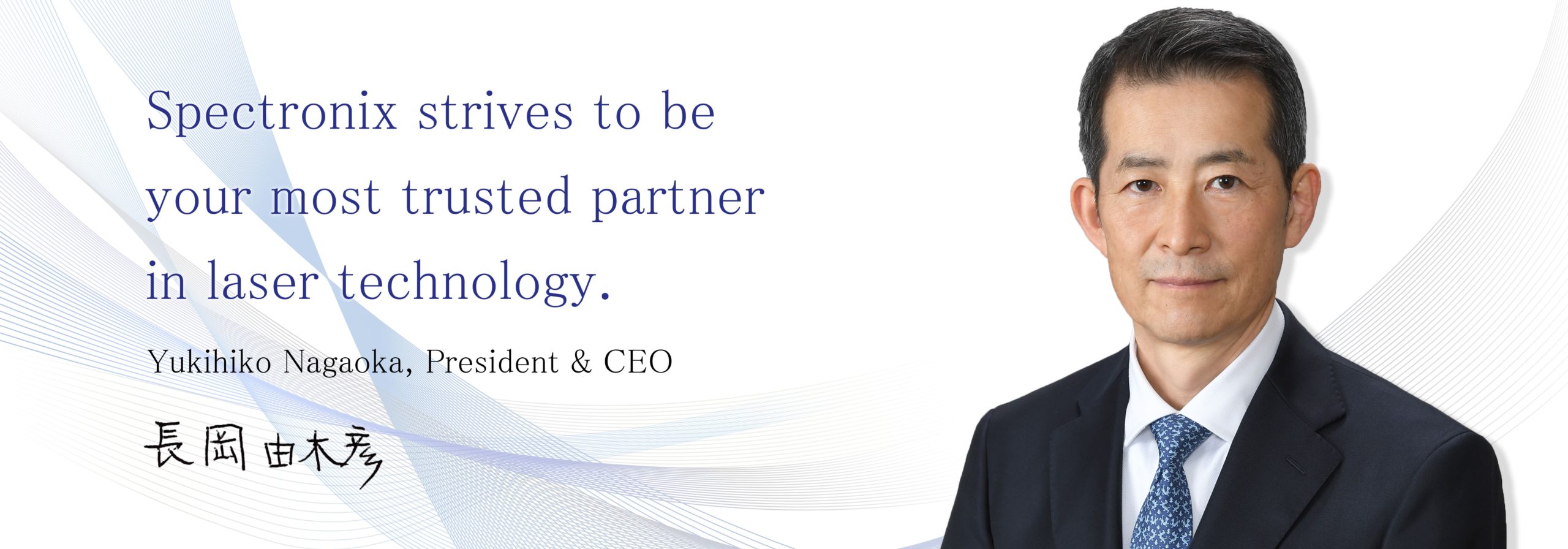Message from the President

Since its establishment by George Okada in 2004, Spectronix has striven to contribute to the industry in the field of microfabrication as a specialist in industrial applications of laser technology. We commercialized the world’s first semiconductor laser gain-switching system (LD-GS) in 2012, which boasts features such as strong vibration resistance and relatively easy amplification due to its simple structure, establishing superior technology for industrial applications with the potential to reduce costs through mass production in the future.
Spectronix is the only manufacturer of industrial picosecond ultraviolet lasers in Japan and the only manufacturer in the world that ships picosecond deep ultraviolet (DUV) lasers*1. We are dedicated to staying ahead of the curve in laser microprocessing technology, working with top institutions like the University of Tokyo-led TACMI Consortium*2 to develop cutting-edge microprocessing AI for advanced devices using Spectronix lasers, and with Osaka University to develop wavelength conversion technology for our world-renowned deep ultraviolet lasers.
Demand for laser microprocessing has increased rapidly due to significant environmental changes, such as the progress of IoT, competition post-5G, advancing CASE in the automotive industry, and carbon neutrality, all of which require miniaturized, power-saving technology with low environmental impact. We have entered an era where the industrial application of picosecond ultraviolet lasers has become the norm, with sights set on progress in the fields of femtosecond and DUV lasers. To meet market needs, Spectronix will continue innovating to provide high-quality, reliable solutions for industrial microprocessing applications while honing our ability to provide the fast yet meticulous customer service of a Japanese manufacturer. Our mission at Spectronix is to contribute to both industry and society through manufacturing as the top global niche company and the only producer of industrial picosecond pulsed lasers in Japan. At the same time, we aim to create a chain of growth for the company and the individual, as an open and dynamic organization that collaborates with research institutions and affiliated partners.
*1: Based on in-house research at the end of February, 2021
*2: TACMI: An abbreviation of Consortium for Technological Approaches toward Cool laser Manufacturing with Intelligence. TACMI collaborates with over 80 companies, universities, and research institutions, with innovation in manufacturing through lasers as its goal.
Reference:http://www.utripl.u-tokyo.ac.jp/tacmi/
Message From the Founder
George Okada, Director and Founder
Since the mid-1990s, it has been my conviction that creating value-added high-tech products invariably requires ultra-fine processing.
However, as I witnessed major Japanese manufacturers that had once driven the advancement of laser technology through national projects withdraw one after another from the ultra-fine processing laser industry after the collapse of the bubble, I grew increasingly concerned that Japan would lose its ultra-fine processing laser technology, a requisite for cutting-edge processing technology. Feeling a sense of stagnation in the domestic industry, I grew determined to bring innovation to factories and revitalize Japanese manufacturing, and, in 2004, founded Spectronix.
When I founded the company, funds were scarce, so Spectronix was set up in the Buddhist altar room of my grandmother’s house in Takatsuki, Osaka, where we commenced a consigned development business centered on laser technology. The business grew steadily through the development and delivery of specialized measuring instruments, medical devices, and ultra-fine processing core modules for research and development at major domestic manufacturers.
We originally purchased all of our lasers, but soon realized that lasers with higher performance and greater user-friendliness were essential for adding value to our consigned development of laser application equipment, and so we began developing our own laser oscillators, using our paltry profits to fund development.
As a venture company with engineers possessing specialized skills from a wide variety of industries, we discussed how to achieve overwhelmingly high quality and ultra-fine laser processing to achieve further growth, and decided to make creating a high-powered DUV ultra-short pulsed laser that was compact and user friendly our development goal.
From the beginning, creating a highly reliable, high-powered DUV laser with solid-state laser technology was said to be impossible, and even leading European and American laser manufacturers were hesitant to develop them.
We decided to take a “zero-base” approach to overturn conventional wisdom and develop a completely new system for a picosecond pulsed laser that combines two unique technologies—the LD-GS laser, which uses a semiconductor laser to directly generates picosecond laser pulses, and a hybrid optical amplifier, which combines optical fibers and crystals—resulting in the world’s first successful commercialization of this technology.
In 2013, we decided to drive company growth by securing funding from external sources based on the fact that we had developed unique laser technology that is (1) highly reliable, (2) makes controlling laser pulses easy, (3) is capable of generating DUV/picosecond pulsed lasers, and (4) can be scaled easily to higher outputs.
We have since worked in cooperation with Osaka University, the University of Tokyo, NEDO, and more to increase the output and reliability of our 266 nm picosecond pulsed laser, which, just as we had predicted when originally envisioning the new laser, has garnered interest from several semiconductor-related companies both in Japan and abroad.
With Yukihiko Nagaoka as our new president, our management structure has been strengthened, allowing us to continue working ceaselessly to ensure that our uniquely developed picosecond pulsed laser contributes to global manufacturing.



